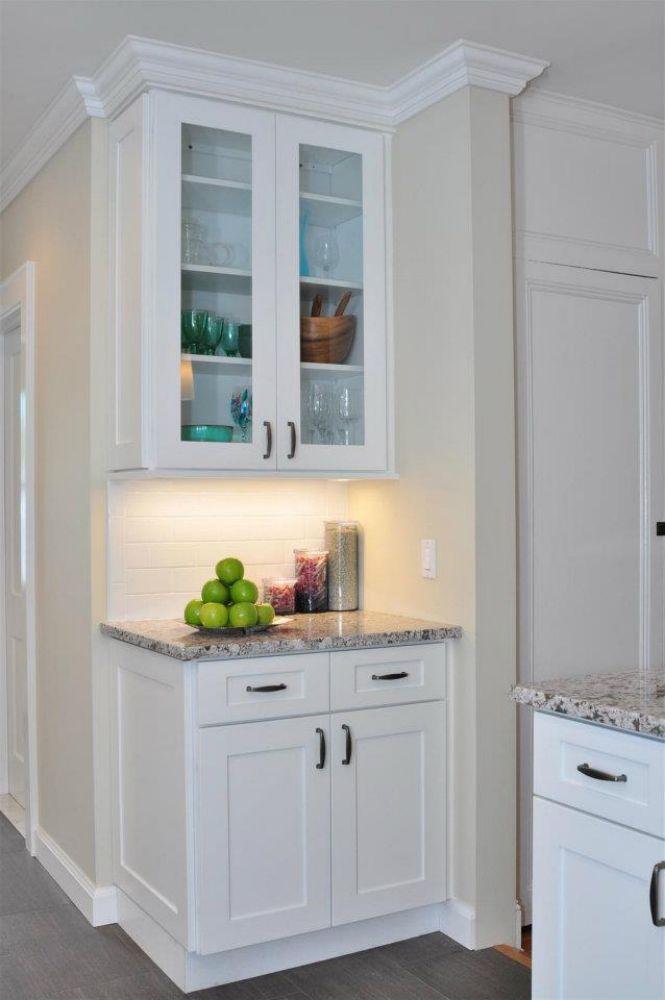Durability Debate: Are Painted Kitchen Cabinets More Likely to Show Wear Than Stained Ones?
When remodeling your kitchen, few choices impact its overall appearance and longevity more than the finish of your cabinets. The debate between painted and stained cabinetry is one of the most common discussions among homeowners and designers. Both finishes offer unique visual appeal, but when it comes to durability and wear, they perform differently over time.
At kitchen cabinets by My Kitchen Cabinets, we help homeowners make informed decisions about materials, finishes, and styles that fit their lifestyle. Choosing between painted and stained finishes involves more than just aesthetics—it’s about understanding how each reacts to daily use, moisture, and cleaning. Whether you prefer a sleek, colorful finish or the natural warmth of wood grain, knowing how each holds up will ensure your investment looks beautiful for years.
Understanding the Difference Between Painted and Stained Kitchen Cabinets
Before comparing durability, it’s essential to understand what sets painted and stained finishes apart in terms of process and appearance.
Painted Cabinets
Painted cabinets involve applying opaque color over the surface of the wood or MDF (medium-density fiberboard). The paint completely covers the wood grain, creating a smooth, even finish. Popular colors include white, gray, navy, and soft neutrals that give kitchens a clean, modern look.
Stained Cabinets
Stained finishes, on the other hand, enhance rather than conceal the natural wood grain. The stain soaks into the wood, adding color while highlighting texture and pattern. Stained cabinets are ideal for those who appreciate the warmth and authenticity of wood tones such as cherry, oak, walnut, or maple.
The choice between paint and stain often reflects aesthetic preference—but the difference in how each finish wears over time can influence long-term satisfaction.
How Painted Kitchen Cabinets Age Over Time
Painted finishes, while beautiful, require a bit more maintenance and care over time compared to stained cabinetry.
1. Visibility of Chips and Scratches
One of the main drawbacks of painted kitchen cabinets is that chips, dents, or scratches are more noticeable, especially on light-colored finishes. When the top layer of paint is damaged, the underlying wood or primer becomes visible, creating contrast.
2. Expansion and Contraction
Wood naturally expands and contracts with humidity and temperature changes. Over time, this can cause hairline cracks in painted surfaces—especially around joints or door frames. While minor, these lines can become visible on smooth, painted finishes.
3. Susceptibility to Dirt and Fingerprints
Painted cabinets, particularly those in matte or satin finishes, tend to show fingerprints, smudges, and grease more easily. Frequent cleaning is necessary to maintain their crisp appearance.
4. Fading Over Time
Direct sunlight can gradually fade painted finishes, especially if darker or more vibrant hues are used. Using UV-resistant paints or window treatments can help prevent discoloration.
Despite these challenges, painted cabinets remain a top choice for homeowners seeking a clean, sophisticated aesthetic.
How Stained Kitchen Cabinets Wear Over Time
Stained cabinetry tends to age more gracefully, thanks to its ability to hide imperfections and highlight the natural beauty of wood.
1. Natural Camouflage for Damage
Because stain penetrates the wood and enhances its grain, minor scratches or dents often blend in rather than stand out. The natural variation in tone and texture helps mask signs of wear.
2. Less Susceptible to Cracking
Unlike painted finishes that sit on top of the wood, stains absorb into it. This means stained cabinets are less likely to develop cracks or peeling caused by wood expansion and contraction.
3. Easier to Touch Up
When damage does occur, stained cabinets are much easier to repair. Small scratches can often be covered with matching stain markers or refinishing kits without needing full repainting.
4. Timeless Aging
As stained cabinets age, they develop a rich patina that many homeowners find appealing. The wood’s natural evolution enhances character rather than detracting from beauty.
For those who value longevity and low maintenance, stained finishes are often the more forgiving option.
The Role of Material in Cabinet Durability
The longevity of both painted and stained cabinets also depends heavily on the base material.
Solid Wood Cabinets
Solid hardwoods like maple, oak, or cherry perform well with both finishes. However, wood’s tendency to expand and contract can affect painted surfaces more visibly than stained ones.
MDF (Medium-Density Fiberboard)
MDF provides a smooth surface that holds paint evenly and resists warping, making it an excellent base for painted cabinets. However, it cannot be stained because it lacks natural wood grain.
Plywood or Veneered Cabinets
High-quality plywood with wood veneers can handle both stains and paints effectively. Veneers mimic the look of real wood while reducing costs, but refinishing options may be limited.
Choosing the right combination of material and finish ensures your cabinetry maintains both beauty and resilience.
Maintenance Differences Between Painted and Stained Cabinets
The upkeep of your cabinets can greatly influence how long they retain their original appearance.
Painted Cabinets
-
Cleaning: Regular dusting and gentle wiping with a damp, non-abrasive cloth are necessary. Avoid harsh chemicals that can dull or chip the finish.
-
Touch-Ups: Paint chips and scratches can be fixed with matching paint, though color matching may be tricky after a few years due to fading.
-
Repainting: After several years, painted cabinets may benefit from a professional repaint to restore their fresh look.
Stained Cabinets
-
Cleaning: Stained finishes are easier to maintain and resist showing grime. Use wood-safe cleaners or a mix of mild soap and water.
-
Touch-Ups: Simple repairs are possible with wood polish or matching stain markers.
-
Refinishing: Stained cabinets can be sanded and restained to refresh color without needing a full overhaul.
Stained cabinets tend to require less frequent maintenance overall, while painted cabinets need consistent care to preserve their appearance.
Appearance and Design Considerations
Aesthetics often play the biggest role in deciding between painted and stained finishes.
Painted Cabinets: Modern Elegance
Painted kitchen cabinets are perfect for homeowners seeking a sleek, uniform look. They suit modern, contemporary, and transitional kitchens with clean lines and smooth surfaces.
-
Ideal for light, airy designs.
-
Works beautifully with trending colors like white, gray, or navy blue.
-
Can create a striking contrast when paired with dark countertops or floors.
Stained Cabinets: Natural Warmth
Stained cabinetry emphasizes the natural beauty of wood grain, adding warmth and character. It’s ideal for traditional, rustic, or farmhouse kitchens.
-
Offers unique variation in color and texture.
-
Pairs well with natural stone and earthy tones.
-
Ages gracefully with timeless appeal.
Your personal style and kitchen’s architectural design should guide your decision.
Cost and Longevity Comparison
1. Cost Considerations
Painted cabinets typically cost slightly more due to labor-intensive preparation and multiple coats of primer and paint. Stained cabinets require less finishing time and materials, making them more budget-friendly.
2. Long-Term Value
Although both finishes can last 10–20 years with proper care, stained cabinets often maintain their look longer without refinishing. Painted cabinets, however, offer flexibility—you can easily update them with a new color in the future.
3. Environmental Factors
In humid climates or high-traffic households, stained cabinets tend to perform better. Painted finishes may require more frequent touch-ups in such environments.
Which Finish Is Better for High-Traffic Kitchens?
In busy kitchens where cabinets endure frequent handling, staining often proves more practical.
-
Painted Cabinets: Show fingerprints, chips, and scuffs more easily. Ideal for low- to moderate-traffic households.
-
Stained Cabinets: Handle daily wear with less visible damage. Excellent for family kitchens and heavy use.
However, with modern technology, high-quality paints and protective coatings now make painted cabinets more resilient than ever before. Choosing premium finishes and proper sealing can minimize visible wear even in active households.
How to Extend the Life of Any Cabinet Finish
Regardless of whether you choose paint or stain, proper care ensures your cabinetry remains stunning for years.
-
Use Soft-Close Hardware: Reduces impact and stress on cabinet surfaces.
-
Control Humidity: Maintain consistent indoor moisture levels to prevent warping and cracking.
-
Avoid Excessive Moisture: Wipe spills promptly, especially around sink and dishwasher areas.
-
Clean Regularly: Use mild soap or wood-safe cleaners—avoid ammonia or bleach-based products.
-
Reapply Protective Topcoats: Every few years, apply a clear sealant or wax to protect surfaces from wear.
Proper maintenance is the key to longevity, regardless of finish choice.
Hybrid Finishes: The Best of Both Worlds
Some homeowners choose to combine painted and stained finishes for aesthetic balance and practical advantages. For example:
-
Painted Upper Cabinets: Provide a bright, modern contrast.
-
Stained Lower Cabinets: Offer durability and conceal everyday wear.
This two-tone approach adds depth and visual interest while optimizing function and resilience.
The Verdict: Which Is More Durable—Paint or Stain?
When it comes to showing wear, painted kitchen cabinets are generally more prone to visible scratches, chips, and dirt accumulation compared to stained finishes. However, advancements in high-quality paints and topcoats have closed the gap significantly.
Stained cabinets naturally hide imperfections better and require less upkeep, making them ideal for households seeking a low-maintenance, long-lasting solution. Painted cabinets, meanwhile, offer unmatched customization, color flexibility, and modern appeal—perfect for homeowners willing to provide occasional touch-ups.
Ultimately, the decision depends on your lifestyle, aesthetic preference, and willingness to maintain your cabinetry.
Conclusion: Balancing Beauty and Durability in Kitchen Cabinet Finishes
Choosing between painted and stained kitchen cabinets ultimately comes down to what matters most to you—flawless modern color or timeless natural beauty. Painted cabinets shine in versatility and design flexibility, offering endless color choices that adapt to evolving trends. However, they demand more careful maintenance to preserve their pristine look.
Stained cabinets, on the other hand, showcase the natural warmth and grain of wood, gracefully concealing wear and aging beautifully over time. They’re the practical choice for busy kitchens, offering long-lasting charm with minimal upkeep.
At My Kitchen Cabinets, we believe your kitchen should reflect your lifestyle and personality—without compromise. Whether you’re drawn to the sleek uniformity of painted finishes or the rustic elegance of stained wood, our expert team ensures you receive durable, premium-quality cabinetry that blends form and function perfectly.
A well-chosen finish not only enhances your kitchen’s design but also extends the life of your investment, creating a space that’s as enduring as it is beautiful.
FAQs About Painted vs. Stained Kitchen Cabinets
1. Do painted cabinets chip easily?
Painted cabinets can chip if exposed to heavy use or impact, especially on corners and edges. However, high-quality paints with durable topcoats minimize chipping and extend the life of the finish.
2. Which finish is easier to repair—painted or stained?
Stained cabinets are easier to repair. Minor scratches or dents can often be fixed with a matching stain pen or refinishing oil, while painted surfaces typically require more noticeable touch-ups.
3. Do painted cabinets require more maintenance than stained ones?
Yes. Painted finishes show dirt, grease, and fingerprints more easily, requiring frequent cleaning. Stained cabinets conceal smudges and wear better, making them more forgiving over time.
4. Can I repaint or restain my cabinets later?
Absolutely. Painted cabinets can be sanded and repainted in a new color, while stained cabinets can be sanded, restained, or refinished to restore their appearance. Both offer opportunities for future updates.
5. How can I prevent painted cabinets from cracking or fading?
Maintain stable humidity levels, avoid harsh cleaners, and use UV-blocking window treatments to prevent sun damage. Applying a protective topcoat every few years also helps preserve color and integrity.
Read: How do I make sure my kitchen cabinets order includes all needed accessories?
Read: How do I plan a kitchen remodel budget with kitchen cabinets as the focus?

